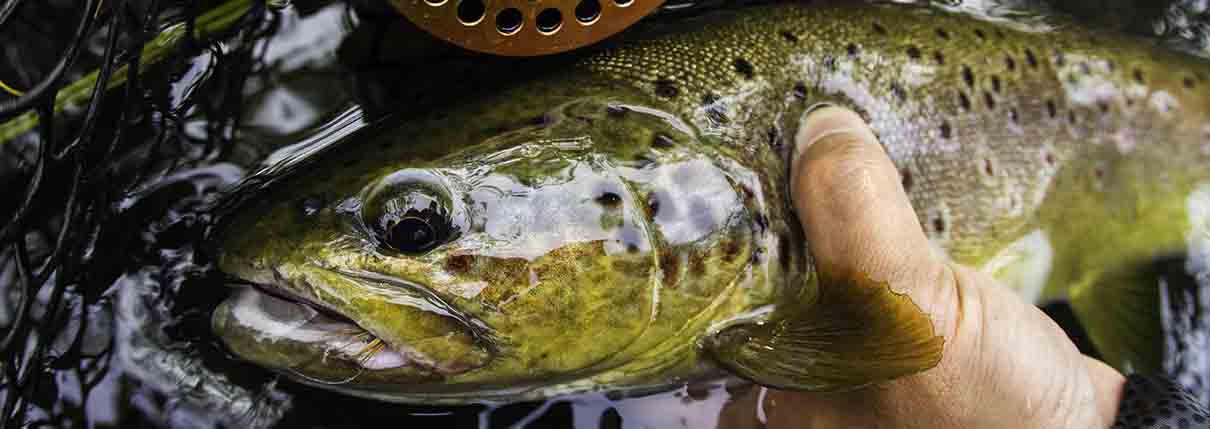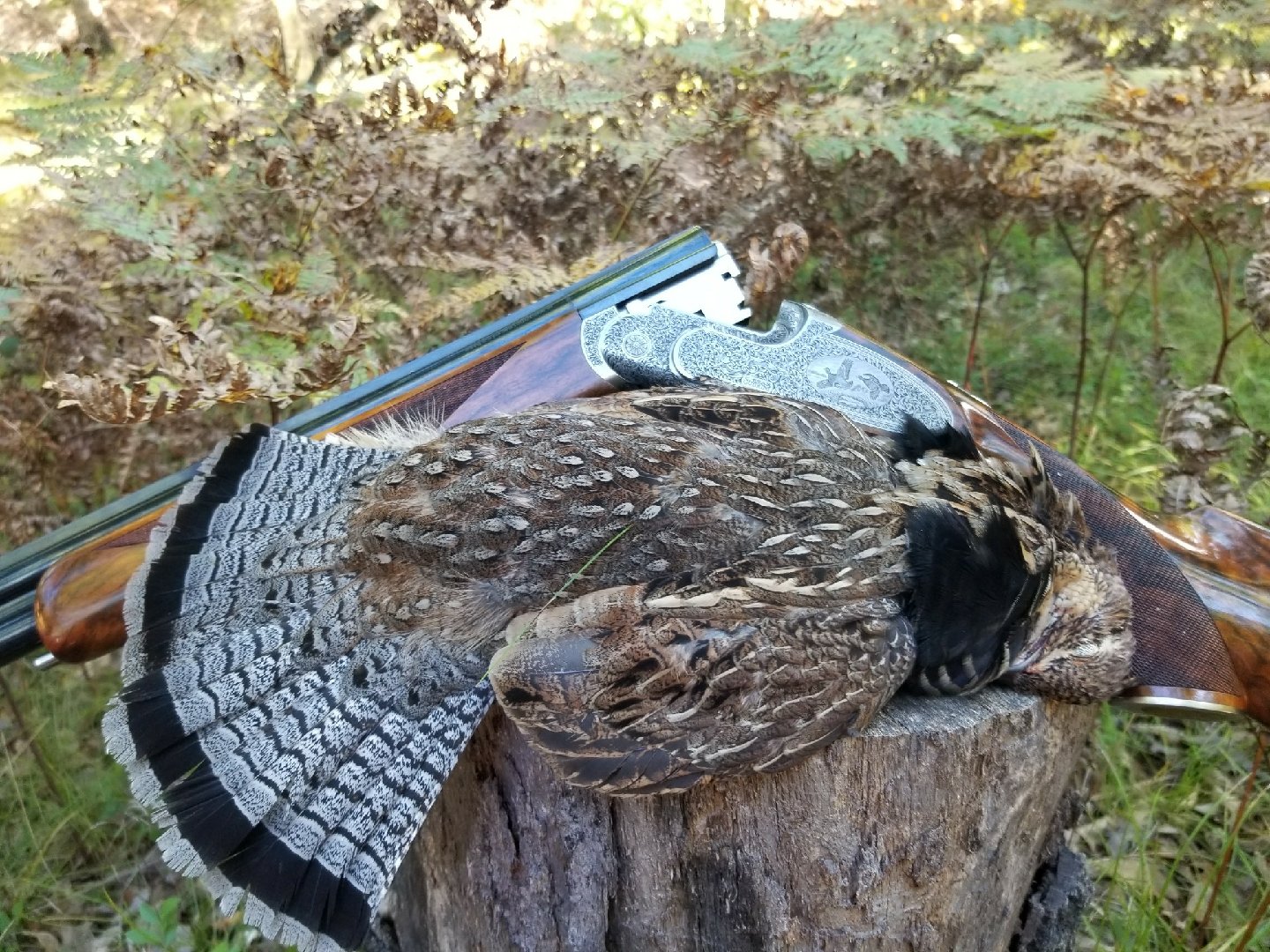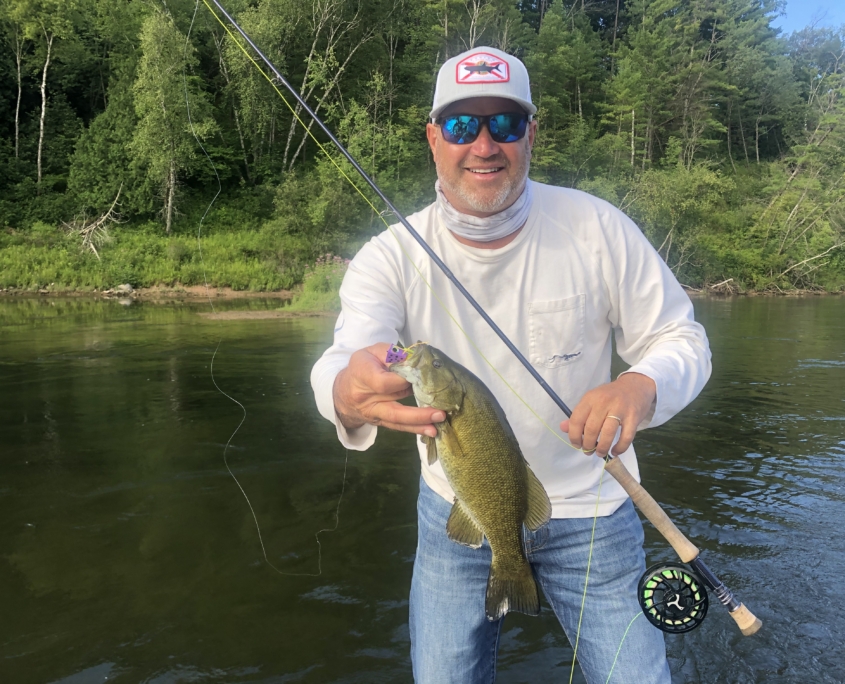Smallmouth Bass
Smallmouth Bass are pound for pound the strongest fighting fish in Michigan Rivers. That is a pretty big statement considering that in Michigan we have steelhead, salmon, muskie , and trout to play with. Still, nothing beats the hard nose pull of a smallmouth bass.
Fly-Fishing for smallmouth bass in Michigan does not get on the front page of most of our websites, newspapers, and fly fishing magazines. That can be the good news for you, because here in Michigan we have some excellent smallmouth bass water to explore that has some of the best smallmouth fishing in the country.
Where to find Smallmouth Bass
Tail water streams like the Manistee, Muskegon, Boardman, and Au Sable Rivers are all examples of rives where the BIG smallmouth bass grow. Above and below these tail waters you will find plenty of food, and where you find food you will find big smallmouth. One of my favorite pictures of a smallmouth is one a client caught a couple of years ago. While fishing below Tippy Dam on the Manistee, we had a fairly big alewife population from the spring spawning run still in the river. We had been throwing big baitfish patterns to imitate these alewives, and my customer at the time hooks up on this fairly nice smallmouth and we bring it to the net. Sticking out of it’s mouth is this half eaten alewife, and hooked in the corner of it’s mouth is our streamer pattern. I don’t know about you, but I love fish that just can’t get enough. That smallmouth just couldn’t let that last baitfish get away; it had to eat it up.
This last story is a prime example as to why I love smallmouth fishing in the summer. First of all, you don’t have to use 8x tippet and tie on a size #24 Trico pattern to go out and catch fish in the summer months. I will always love the pull of big fish and I love seeing the action happen right in front of me. Smallmouth fishing is very visual; to get these high protein eating machines to come to a fly you can throw anything from poppers to dying baitfish patterns to crayfish. Fishing these types of flies is very visual to the angler, all these patterns draw attention to themselves. When fishing these patterns you have to be paying attention. Smallmouths have the ability to draw in their prey with a quick sucking strike. For the most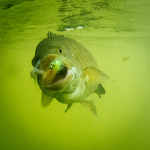 part, smallmouth like to lie in the slower parts of Michigan Rivers. Not to say you will not find them in the riffles of the Muskegon or Hoydenpyle section of the Manistee, but for the most part smallmouth are lazy river users, they slowly swim around looking for prey. In this slower current you really need to be in touch with your fly, a smallmouth really does suck in its prey. While some strikes are very vicious and the rod can be yanked right out of your hand, other strikes can be so soft you will not even feel it. I have seen smallmouth come up behind clients flies, suck them in and spit them out before I can even get the words out to “set the hook” or “hit it”. In the clear water conditions that most Michigan Rivers have in the summer, wearing your polarized sunglasses and paying close attention to your smallmouth offering is key to success.
part, smallmouth like to lie in the slower parts of Michigan Rivers. Not to say you will not find them in the riffles of the Muskegon or Hoydenpyle section of the Manistee, but for the most part smallmouth are lazy river users, they slowly swim around looking for prey. In this slower current you really need to be in touch with your fly, a smallmouth really does suck in its prey. While some strikes are very vicious and the rod can be yanked right out of your hand, other strikes can be so soft you will not even feel it. I have seen smallmouth come up behind clients flies, suck them in and spit them out before I can even get the words out to “set the hook” or “hit it”. In the clear water conditions that most Michigan Rivers have in the summer, wearing your polarized sunglasses and paying close attention to your smallmouth offering is key to success.
With so much visual fishing for smallmouth bass, and yes with so many opportunities to catch and release smallmouth, smallmouth are a great way to introduce beginners to the sport of fly-fishing. Don’t let that mislead you about smallmouth though. Not all smallmouth bass are easy to catch. There is certain water and certain sizes of smallmouth that are very picky. In those slow moving pools that we talked about that smallmouth bass like to swim around in, especially those bigger 2-5lb bronze back brutes, they can look at your fly for a very long time. Deciding to eat it or not, you’re going to have to fool them, learning what retrieve to use and when.
Smallmouth Bass Improve your Angling Skills
Also with smallmouth, I see these fish as a great cross trainer for other types of fishing. If you have plans to go saltwater fishing, smallmouth can give you that cross training, that practice that you will need. You will learn to strip set on your hook sets. What is strip setting? It is when you set the hook with the line, not the rod. If you set the hook like you do when you are dry fly fishing, you will have a higher loss rate on your smallmouth. Smallmouth have a very hard mouth, they use this hard mouth to crush their prey. You need to bury the hook, you can’t set hard enough using the rod, and you need to strip the line as you set, or strip set. Also if you are fishing for some of the bigger smallmouth bass in Michigan, you get to use your 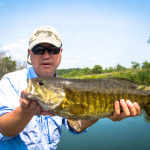 8 weight fly rods, the same rod you use for bonefish. As I told you in the beginning, these are the hardest fighting pound for pound fish in Michigan. If you decide to go after those 3lb and bigger smallmouth you’re going to want some backbone in your rod. Smallmouth bass will use the current of the river to their advantage; they will take you back into the wood if you’re not careful. The greatest cross training attribute of smallmouth is the fact that you get to practice your streamer fishing. Not only do you get to practice but you get to have success doing it. Most of your trout streamer patterns are going to work on smallmouth. Yes, we have specialty patterns for these smallmouths like the F.D.S and the Pancora Bugger, but for the most part anything that looks alive and edible will do the trick.
8 weight fly rods, the same rod you use for bonefish. As I told you in the beginning, these are the hardest fighting pound for pound fish in Michigan. If you decide to go after those 3lb and bigger smallmouth you’re going to want some backbone in your rod. Smallmouth bass will use the current of the river to their advantage; they will take you back into the wood if you’re not careful. The greatest cross training attribute of smallmouth is the fact that you get to practice your streamer fishing. Not only do you get to practice but you get to have success doing it. Most of your trout streamer patterns are going to work on smallmouth. Yes, we have specialty patterns for these smallmouths like the F.D.S and the Pancora Bugger, but for the most part anything that looks alive and edible will do the trick.
Just as the elusiveness of a 24” brown keeps me out late hours on evenings of the hex hatch, throwing poppers and dying baitfish patterns to the structure for a alb smallmouth bass gets me excited for the warmth of the summer. Michigan river smallmouth are big, they pull hard, and I get to see most strikes up close and personal. If you have not tried it yet, you are missing out on one of Michigan’s best fisheries.

